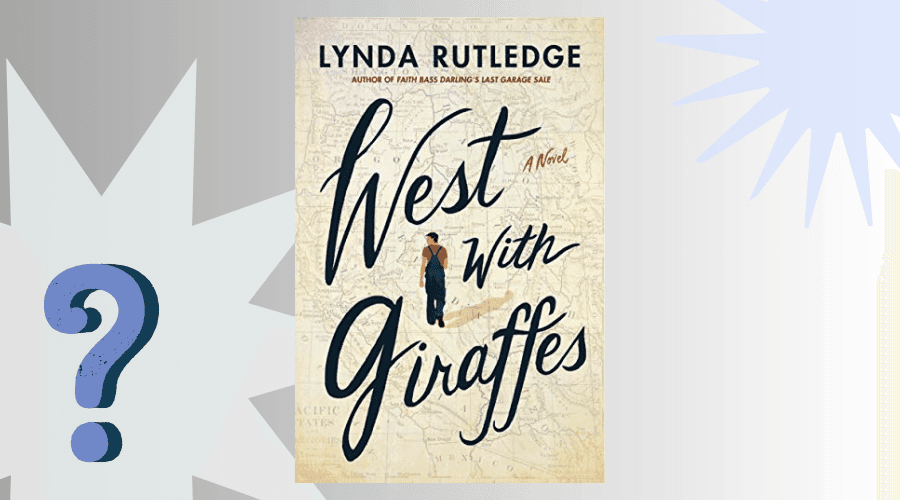West With Giraffes would be such a great choice for a book club because of its themes about resilience, survival, and that unique bond between humans and animals against the richly woven background of America in 1938, during the Great Depression. The story, based on true events, follows the journey of Woody Nickel as he transports two giraffes across the country-a story full of personal growth, historical challenges, and quirky yet touching storyline. It is an easy read, yet layered, making it perfect for both casual readers and those who love diving deep into character development and symbolism. And honestly, who doesn’t love a story with heartfelt animal moments?
20 West With Giraffes Book Club Questions (+Answers)
Here are 20 book club questions and answers for West With Giraffes by Lynda Rutledge. These are designed to spark engaging discussions while providing insight into key aspects of the book.
- What role does the historical backdrop of 1938 America play in the story?
Answer: It reflects the hardships of the Great Depression and Dust Bowl era, highlighting the struggle for survival and the perseverance of both people and animals. - How does Woody Nickel evolve as a character throughout the story?
Answer: Woody starts as a desperate, naive teenager but grows into someone more responsible and compassionate, finding purpose and connection through the giraffes and their journey. - What do the giraffes symbolize in the story?
Answer: They symbolize hope, resilience, and the beauty of life, even during hard times. - Why is the journey across the country so significant for Woody?
Answer: It becomes a metaphor for his own journey of self-discovery and healing after experiencing loss and trauma. - How does the relationship between Woody and Riley (the Old Man) develop?
Answer: Their relationship evolves from mistrust to mutual respect, as Riley becomes a father figure and mentor to Woody. - What do the giraffes teach Woody about life?
Answer: They teach him about empathy, perseverance, and the importance of protecting the vulnerable. - How does the book balance historical fact and fiction?
Answer: Rutledge blends real events (the giraffes’ journey) with fictionalized characters and emotional depth to create a vivid, believable story. - How does the author use nature to enhance the story?
Answer: The descriptions of the giraffes and landscapes create a sense of wonder and connection to the natural world, contrasting with the harsh realities of human struggles. - What does Woody’s bond with the giraffes reveal about his character?
Answer: It shows his capacity for growth, compassion, and a deep sense of responsibility. - What challenges do the characters face on their journey?
Answer: They deal with physical dangers like weather and terrain, as well as societal obstacles like prejudice and the lingering effects of the Depression. - How does the book explore the theme of loss?
Answer: Woody’s losses—his family, his home, and his innocence—drive his actions and growth throughout the story. - Why is Riley’s character so significant to the story?
Answer: He acts as a stabilizing force and mentor, helping Woody mature and teaching him the importance of loyalty and resilience. - How does Augusta Red contribute to the story?
Answer: She adds complexity with her own backstory and motivations, as well as a spark of romance and rivalry that challenges Woody. - What role do the giraffes play in bringing the characters together?
Answer: They act as a unifying force, giving Woody, Riley, and Augusta a shared goal and emotional connection. - How does Woody’s narration as an old man affect the story?
Answer: His reflective tone adds layers of nostalgia and wisdom, making the story feel both personal and poignant. - What message does the book convey about perseverance?
Answer: It emphasizes that even in the toughest times, perseverance can lead to personal growth and unexpected beauty. - Why do you think the author chose giraffes as the central animals?
Answer: Their elegance, vulnerability, and rarity during the time symbolize hope and resilience in the face of adversity. - How does the journey mirror the larger societal struggles of the era?
Answer: It reflects the desperation, determination, and small joys that people experienced during the Great Depression. - What emotions did the book evoke for you while reading?
Answer: Responses may vary, but common emotions include hope, joy, sadness, and inspiration. - How does the ending tie together the themes of the story?
Answer: The ending reflects the lasting impact of the journey on Woody’s life, showing how moments of compassion and courage shape us forever.
West With Giraffes: Discussion Topics
Here’s an expanded version of the top 5 discussion topics for West With Giraffes to make your book club conversation even more engaging:
1. Resilience and Survival
- Focus: The theme of resilience runs throughout the story, not just for the characters but also for the giraffes. Discuss how each character demonstrates their own form of resilience—whether it’s Woody surviving his traumatic past, Riley persevering through his mission, or the giraffes enduring their tumultuous journey.
- Questions to Explore:
- How does Woody’s struggle to survive during the Great Depression shape his decisions and outlook on life?
- How do the giraffes’ physical and symbolic journeys reflect the resilience needed to navigate life’s challenges?
- How does the concept of survival shift from the beginning of the story to the end?
2. The Bond Between Humans and Animals
- Focus: The relationship between Woody and the giraffes is central to the story. It goes beyond simple care-taking, delving into themes of connection, trust, and empathy.
- Questions to Explore:
- Why do you think Woody forms such a deep bond with the giraffes?
- How do the giraffes serve as a source of healing and purpose for Woody?
- What do the giraffes symbolize to Woody, Riley, and even Augusta?
- How does this bond reflect broader themes about the human-animal connection and our responsibility to care for the vulnerable?
3. The Role of Mentorship
- Focus: Riley (the Old Man) plays a crucial role as a mentor to Woody, helping him navigate not only the journey but also his own personal growth. Their evolving relationship provides a lens to discuss trust, guidance, and maturity.
- Questions to Explore:
- How does Riley’s mentorship change Woody’s perspective on life and responsibility?
- What are some pivotal moments where Riley teaches Woody important lessons?
- How does Riley’s tough yet compassionate demeanor help Woody become more independent?
- Compare Riley’s influence to that of other mentors you’ve read about in literature.
4. Historical Context and its Influence
- Focus: The Great Depression and Dust Bowl serve as more than just a backdrop—they are woven into the characters’ struggles, motivations, and decisions. The societal challenges of the time highlight themes of scarcity, hope, and determination.
- Questions to Explore:
- How do the economic and environmental challenges of the 1930s shape the characters’ actions?
- In what ways does the historical context add realism and depth to the story?
- How does the journey across America reflect the larger struggles of the time period?
- Discuss how the book portrays class, race, and gender during the Depression.
5. Hope and Transformation
- Focus: Despite the hardships, the book is ultimately a story of hope and transformation. The journey is not only physical but emotional, as Woody evolves from a lost teenager to someone with purpose and direction.
- Questions to Explore:
- What are some key turning points in Woody’s transformation, and how do the giraffes play a role in them?
- How do small moments of beauty, such as the giraffes’ grace or the kindness of strangers, provide hope amidst hardship?
- How does the book balance its portrayal of struggle with moments of lightness and inspiration?
- What message does the ending leave about hope, resilience, and the possibility for change?
How to make Your West With Giraffes Book Club more Interactive?
Here are more bonus ideas to make your West With Giraffes book club extra fun and thought-provoking:
Compare and Contrast
If your book club enjoys comparing stories, you could discuss West With Giraffes alongside other historical fiction or animal-centric novels, like The Nightingale by Kristin Hannah or Water for Elephants by Sara Gruen. This could spark conversations about how different books approach similar themes, such as survival, hope, and human-animal bonds.
Map the Journey
Print a map of the United States and trace the giraffes’ journey from New York to San Diego. Mark key locations mentioned in the book and discuss how each stop contributes to the story and the characters’ growth.
Discuss Animal Rights & Conservation
Dive into a discussion about animal conservation efforts today. Compare the historical challenges of transporting and caring for exotic animals in the 1930s to modern practices. How far have we come, and what lessons can we learn from the story?
Explore Real-Life Inspiration
Research the true story that inspired the novel—the journey of the giraffes to the San Diego Zoo in 1938. Discuss how the author blended fact with fiction and whether you’d have approached the story differently.
Personal Connections to Animals
Ask each book club member to share a story about a special animal in their own life. How did that relationship impact them, and can they relate it to Woody’s bond with the giraffes?
Author Spotlight
Research Lynda Rutledge’s background and writing process. Discuss what might have inspired her to tell this story and how her perspective as an author shaped the narrative.

